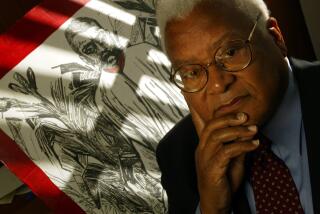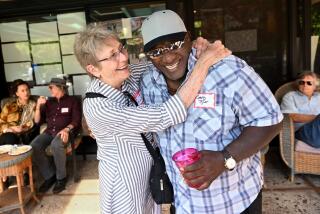A Deft Look at the Early Years of ‘Soup, Soap and Salvation’
- Share via
Remaking the Salvation Army in America, 1880-1930
By Lillian Taiz
University of North Carolina Press
$16.95 paper, 272 pages
So who are those people in the blue suits standing by the kettles, playing a horn or accordion? Where do they come from to dot the mall-scape at the holidays, and where do they go afterward?
The Salvation Army, which originated in England, arrived in the United States 121 years ago in the person of George Scott Railton--an evangelical Britisher who’d once set out, single-handedly, to convert Morocco to Christianity--and eight “Hallelujah Lasses,” single women “officers,” or ministers in the fledgling movement. Promising to “lay siege” to New York, the small band contented itself with occupying a stage in a dance hall one evening.
Today the Army remains an evangelical Christian church--and a leading provider of social services and housing. In and around Los Angeles, the movement provides housing and help for people with AIDS, transitional housing for families trying to escape poverty and homelessness and a community center in Pico-Union that may be the only Salvation Army unit to house a ballet school.
How the movement went from a Bowery dance hall to ballet--and the continuing tension between its social services and its evangelism--is detailed in Lillian Taiz’s book “Hallelujah Lads & Lasses,” a history of the group’s early years. Taiz, a professor at Cal State L.A., examines how these Christian missionaries brought their “red-hot religion” to a young and growing nation.
This engaging, thoroughly documented volume tells the story of a religious movement that had to deal with a distant but demanding headquarters, contentious local troops and opposition from the public and the press.
Methodist preacher William Booth began the Salvation Army in 1865 as the Christian Mission to East London, when he found that “respectable” churches wouldn’t accept the poorly dressed and ill-educated people he’d converted in open-air meetings in that slum area. Eschewing “high church” stuffiness and co-opting songs from music halls, the Salvation Army spread like wildfire throughout England by making religion and moral help accessible.
America beckoned as a land of cities teeming with poor people who needed Booth’s gospel of “soup, soap and salvation.” Railton, perhaps Booth’s most fervent disciple, flitted about the country trying to get often-indifferent audiences to respond. At one point, he strapped on ice skates and stood on a frozen Mississippi River to preach to astonished St. Louisans standing on the shore.
Starting with dramatic conversions of street-corner drunks in New York, the Salvation Army’s two-pronged effort evolved into what became almost competing camps. The church part, its membership drawn from the working and nascent middle classes, wanted just that: a church. Those tasked with what became the “social wing” of rehabilitation centers and shelters wanted more resources and respect from the leadership.
Those leaders, however, had their own problems. Booth, the Salvation Army’s first “general” from 1865 to 1910, was brilliant, motivational and thoroughly committed to the Methodist-born holiness he preached relentlessly. He was also an autocrat of the first order: When “The General” said to do something, it was to be done.
America, however, had its own seductive charms for those Booth sent. Almost all did not want to surrender their commands when told to “farewell” for another posting. One tried to incorporate the Salvation Army independent of its British parent. Booth’s son Ballington, sent to quell that uprising, left with his wife to found the Volunteers of America rather than return home at his father’s instruction.
Only with the arrival of Cmdr. Evangeline Cory Booth, one of William’s daughters, did the Army come into its own. “The Commander in Rags,” as she styled herself, quelled dissension and won admirers ranging from merchant prince John Wanamaker to presidents Theodore Roosevelt and Woodrow Wilson.
It was Evangeline, who would later become the group’s first woman general, who came up with the “Doughnut Girls” (and men) who served troops on the front lines of France in World War I, and it was she who rallied support for Depression-era soup kitchens, with a famous poster proclaiming, “A Man May Be Down, but He’s Never Out.”
Taiz does what writer Diane Winston failed to do in her 1999 history, “Red-Hot and Righteous”: offer a fully orbed picture of the movement.
Taiz’s research brings to life conflicts within the group, some of which are echoed today. Yet the Army’s triumph over schism and reactionary sentiment in the early 20th century offers a hopeful element for the 21st: As purveyors of social services and a religion that seeks “to put a new man in every coat,” as Booth once said, the Salvation army has been able to adapt.
More to Read
Sign up for Essential California
The most important California stories and recommendations in your inbox every morning.
You may occasionally receive promotional content from the Los Angeles Times.













